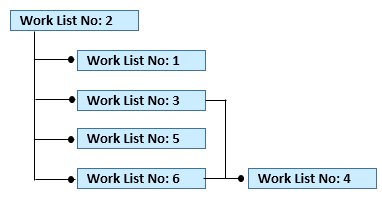Prepare PM Action
When a PM action has been created and generation conditions defined, you can continue to prepare the PM action with additional information.
Prepare PM Action
When you prepare a PM action you can, in addition to the generation criteria, enter work instructions, material requirements, resource demand requirements, external costs and expenses requirements. You can also enter jobs to connect Work Task Templates. In addition, jobs are also used to organize materials, work lists, resource demands and any planning lines.
Resource group requirements of a PM action can be broken down into multiple work lists. This is useful if you need to describe in what sequence certain steps should be done, and which resource group and/or maintenance organization will be involved in the different work lists. For each work list, you can also specify whether a maintenance team should be responsible for executing it. If so, you can only enter maintenance organizations and resource groups connected the maintenance team. Furthermore, you can also include additional qualifications (i.e., competencies and certificates) that might be required for each work list (only applicable if IFS Human Resources is installed).
For work orders that have a series of work tasks, manual rescheduling can be cumbersome. To make the job a lot more easier and efficient, you can connect the work task lines to form a hierarchical structure, that is a Dependency (i.e., Parent - Child) relationship. Including this structure in the PM actions makes the job even more simple. Consider the following example: A PM action has six work lists connected as shown below.

Work List No: <x> = Work List Number <x>
Thus, the dependencies for each work list number is as follows:
| Work List Number | Predecessor |
| Work List No: 1 | 2 |
| Work List No: 2 | None |
| Work List No: 3 | 2 |
| Work List No: 4 | 3,6 |
| Work List No: 5 | 2 |
| Work List No: 6 | 2 |
Note: You cannot delete work list lines that act as dependencies. For instance, in the above example, work list numbers 2, 3, and 6 cannot be deleted. You will have to remove the dependency in order to delete the work list lines. Furthermore, you cannot create relationships that loop. For example, work list no: 1 cannot be included as the dependency of work list no: 2. To do so, you will have to remove the dependency and re-define it. Also you cannot include work list no: 4 as a dependency to work list no: 2, since work list no: 2 is an indirect dependency of work list no: 4.
As with all other information included in the PM action, the dependencies will also be copied to the work order when it is generated.
You can also connect permit types to the PM action which can be useful if certain safety regulations needs to be followed when performing the task.
Furthermore, you can create new, or connect existing documents to the PM action. You can also link your PM actions to structures, which is useful when a job involves several maintenance organizations, and you want to create a work order for each maintenance organization.
In IFS/Service Management, in addition to the information above, you can also enter a customer identity and service contract (if applicable).
The preparation of the PM action can be simplified by connecting a Work Task Template containing work description, work lists, material requirements, resource demands (person and/or tool/equipment) and/or connected documents. The Work Task Templates are connected through jobs and templates. The PM action will inherit the information entered in the Work Task Template when connected. If need be you can add more information, or delete information.